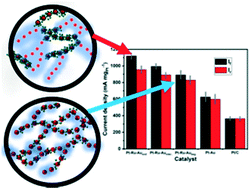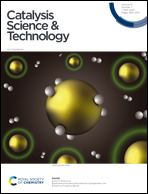Formation of microns long thin wire networks with a controlled spatial distribution of elements†
Abstract
The performance and lifetime of a multi-element catalyst are critically affected by the relative domain size of the constituting elements and their distribution. These become more critical for noble metal catalysts where optimization is required due to their cost. Here we present a simple self-assembly process that allows control over the spatial distribution of the catalytic elements on the scale of a few nanometers. The self-assembly, based on the distribution of the ions in the electrical double layer over colloidal nanoparticles, results in the formation of a network of thin wires of the catalytic elements. The wires are 2–5 nm in diameter while their length is in microns. As presented for a Pt–Ru system towards ethanol oxidation, we show that by optimizing the domain size of the elements and their distribution, the catalyst performance is increased by 30%, while maintaining the same elemental composition, and by over 3 times compared to a commercial Pt catalyst. Further, its carbon monoxide (CO) oxidation potential is also reduced by 0.14 V compared to that of the commercial Pt catalyst, resulting in greater tolerance and lifetime for the catalyst, illustrating the use of this simple method to enhance the catalytic performance.



 Please wait while we load your content...
Please wait while we load your content...